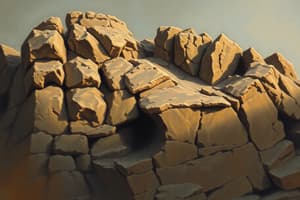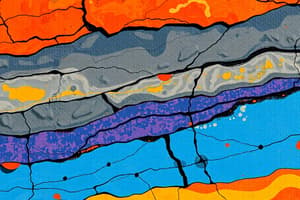Podcast
Questions and Answers
What defines clastic sedimentary rocks and how are they classified?
What defines clastic sedimentary rocks and how are they classified?
Clastic sedimentary rocks are formed from accumulated fragments of pre-existing rocks and are classified based on particle size, such as claystone, breccia, and others.
Identify two types of chemical sedimentary rocks and their formation processes.
Identify two types of chemical sedimentary rocks and their formation processes.
Limestone, formed from marine organisms or direct precipitation of calcite, and rock salt (halite), formed from the evaporation of saline water.
Explain the role of lithification in the formation of sedimentary rocks.
Explain the role of lithification in the formation of sedimentary rocks.
Lithification turns sediment into rock through compaction, which reduces pore space, and cementation, where minerals precipitate and bind sediments together.
What are the main processes involved in sedimentation and how do they interact?
What are the main processes involved in sedimentation and how do they interact?
Describe the difference between breccia and claystone.
Describe the difference between breccia and claystone.
Flashcards are hidden until you start studying
Study Notes
Types of Sedimentary Rocks
Clastic Sedimentary Rocks
- Formed from the accumulation of fragments (clasts) derived from pre-existing rocks.
- Classified based on particle size:
- Claystone: Fine particles (<0.002 mm).
- Siltstone: Silt-sized particles (0.002 - 0.062 mm).
- Sandstone: Sand-sized particles (0.062 - 2 mm).
- Conglomerate: Larger, rounded gravel-sized clasts (>2 mm).
- Breccia: Larger, angular gravel-sized clasts.
- Common minerals include quartz, feldspar, and clay minerals.
Chemical Sedimentary Rocks
- Formed from the precipitation of minerals from solution or biological activity.
- Common types include:
- Limestone: Primarily composed of calcite; can form from marine organisms or direct precipitation.
- Rock Salt (Halite): Formed from the evaporation of saline water.
- Gypsum: Resulting from evaporation and precipitation of sulfate minerals.
- Chert: Composed of microcrystalline silica; can form from the accumulation of silica from organisms or precipitation.
Sedimentation Processes
- Weathering: Breakdown of rocks into smaller particles through physical, chemical, or biological processes.
- Erosion: The movement of sediment by wind, water, or ice.
- Transportation: Movement of sediment from the source to the deposition site through agents such as water currents, wind, or glaciers.
- Deposition: Accumulation of sediment when the transporting medium loses energy, leading to sediment settling.
- Lithification: The process of turning sediment into rock, involving:
- Compaction: Reduction of pore space due to overburden pressure.
- Cementation: Minerals precipitate from water and fill the spaces between sediments, binding them together.
Clastic Sedimentary Rocks
- Formed from the accumulation of rock fragments called clasts originating from pre-existing rocks.
- Classified by particle size:
- Claystone consists of fine particles (less than 2 mm).
- Breccia features larger, angular clasts typically gravel-sized.
- Common minerals in these rocks include quartz, feldspar, and various clay minerals.
Chemical Sedimentary Rocks
- Result from mineral precipitation from water solutions or biological activity.
- Notable types include:
- Limestone: Mainly comprises calcite, formed either biologically through marine organisms or by direct mineral precipitation.
- Rock Salt (Halite): Created through the evaporation of saline water, concentrating dissolved minerals.
- Gypsum: Forms through evaporation and subsequent precipitation of sulfate minerals.
- Chert: Consists of microcrystalline silica, originating from the accumulation of silica from organisms or as a direct precipitate.
Sedimentation Processes
- Weathering: Involves the breakdown of rocks into smaller particles through physical, chemical, or biological means.
- Erosion: Refers to the transport of sediment by wind, water, or ice, removing materials from their original location.
- Transportation: Movement of sediment to deposition sites via agents such as water currents, wind, or glaciers.
- Deposition: Occurs when transporting media lose energy, allowing sediments to settle and accumulate.
- Lithification: Process transforming sediment into sedimentary rock, encompassing:
- Compaction: Reduction of pore space in sediment due to the weight of overlying materials.
- Cementation: Occurs when minerals precipitate in pore spaces between sediments, effectively binding them together.
Studying That Suits You
Use AI to generate personalized quizzes and flashcards to suit your learning preferences.




